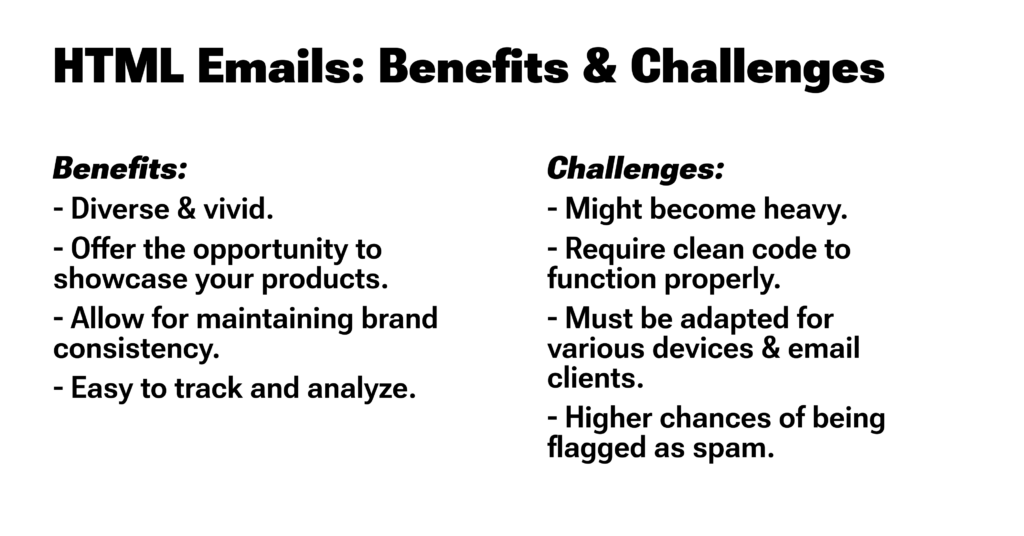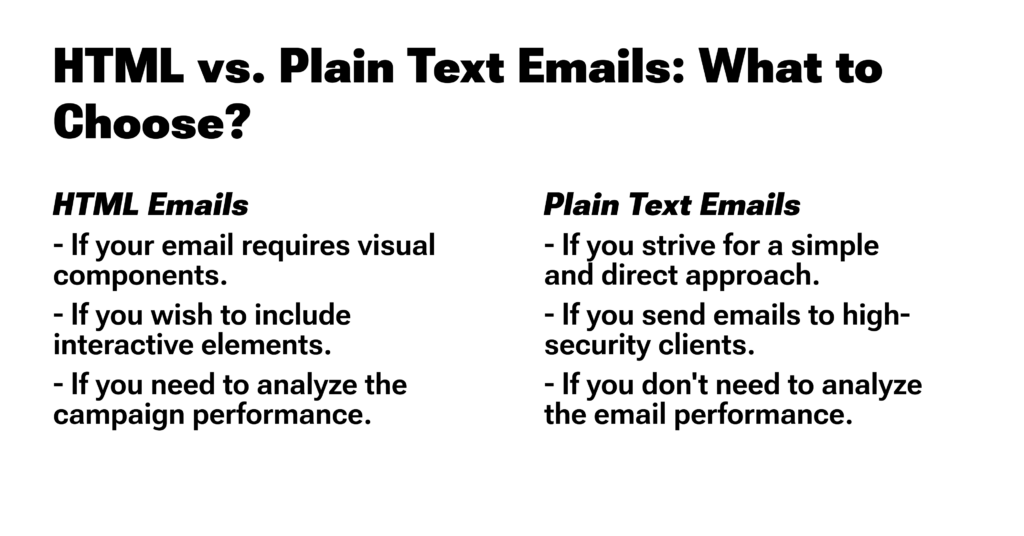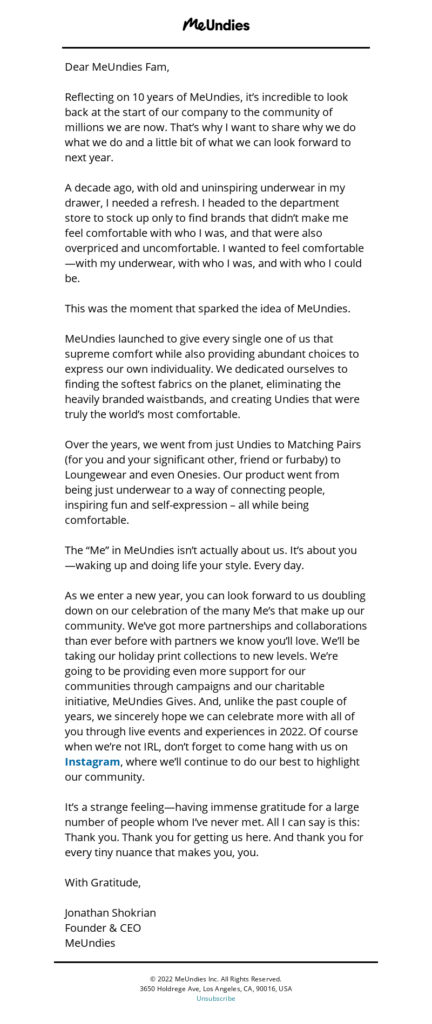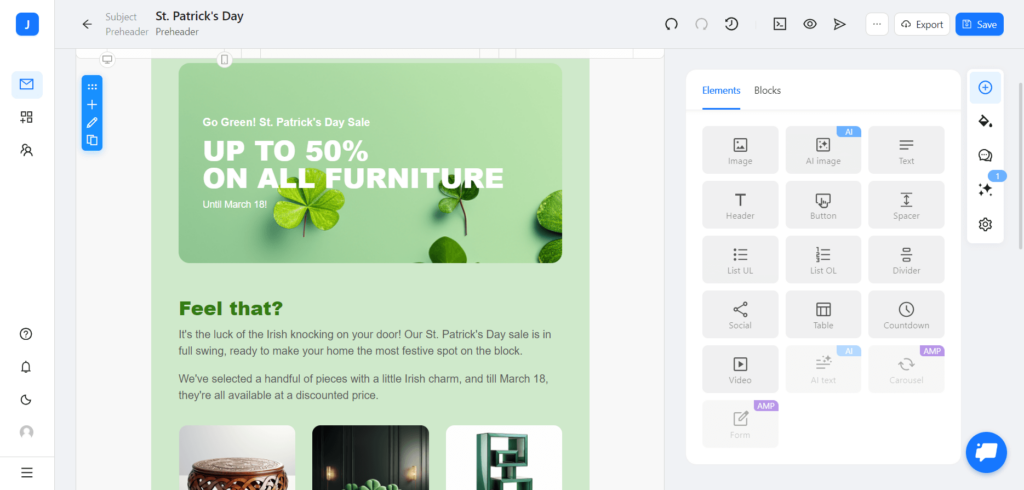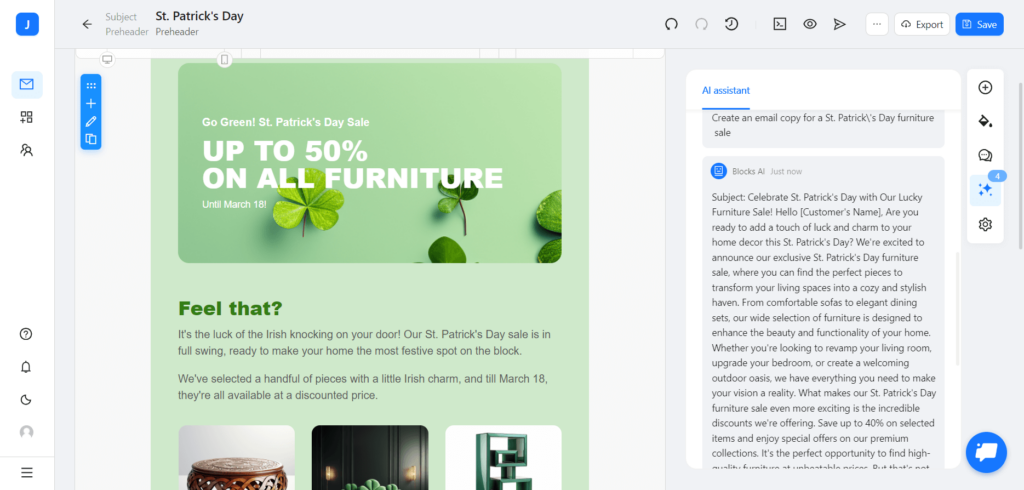HTML vs. Plain Text Emails: What to Choose in 2024?
Emails have gone a long way since their inception. At first, they were simple, bare-bones text messages. Yet as the technologies developed, HTML (HyperText Markup Language) made them colorful and lively with visuals, animations, and multimedia.
But the good old plain text emails never went away. In fact, they’re still going strong, even to this day. And that’s exactly what leads us to the “HTML vs. plain text emails” showdown.
Dive into our article to learn:
- what is the difference between HTML and plain text emails;
- what are the benefits and challenges of HTML and plain text emails;
- when to use either HTML or plain text emails;
- why is it better to create a plain text email alongside the HTML email;
- how Blocks may assist you in email design.
What is the Difference Between HTML and Plain Text Emails?
The difference between HTML and plain text emails is rather huge in both the visual presentation and the technical aspects.
Let’s start with the HTML emails. Basically, they are everything you’d expect from a marketing message: stylized, vivid, with tons of different elements. Under the hood, HTML emails contain code that makes them work as intended.
Here’s a great example of an HTML email:
Plain text emails are the complete opposite. They contain regular text only, without any graphics or multimedia elements whatsoever. At first glance, plain text emails might seem like a blast from the past, but they remain surprisingly relevant.
Here’s what a plain text email looks like:

HTML vs. Plain Text Emails: Benefits & Challenges
62% of marketers use a hybrid of HTML and plain text emails as part of their strategy. This impressive number shows that both types are still very much in use, and neither of them is going away any time soon.
Of course, since HTML and plain text emails are 2 distinct types of messages, each of them has specific benefits and challenges. Let’s take a closer look.
HTML Emails: Benefits
HTML emails are packed with a significant bunch of benefits that include:
1. Content variety. When it comes to diverse content, HTML emails are an absolute winner. Thanks to HTML, you may fill your email with an assortment of different elements:
- pictures;
- animations;
- CTAs;
- videos;
- mini-games;
- and more!
2. Product showcase. Whenever you need to demonstrate your products in full glory, HTML becomes a perfect choice. Vivid graphics and dynamic content will provide a full view of what you have to offer.
3. Brand consistency. HTML is widely used in email marketing, and for a good reason. It allows you to include all the required brand elements (logos, fonts, colors) and maintain consistency. This, in turn, provides higher brand recognition.
4. Ease of monitoring. HTML emails are perfect for collecting analytical data. Modern ESPs and CDPs allow you to analyze the metrics of your campaign in detail. This gives a better understanding of your emails’ performance and lets you build a long-term strategy.
HTML Emails: Challenges
HTML emails are excellent but still come with a fair share of challenges. In particular:
1. Size issues. Pay special attention to the size of your message. An HTML email filled with heavy content takes a lot of time to load. Your subscribers won’t be happy to receive such a bulky email and might even ignore your messages in the future.
2. Clean code required. Code is the heart of an HTML email. Keep it clean, without errors or any excessive components. Mistakes in the code might break your email while too many elements will make it bloated.
3. Responsiveness. Nearly 1.7 billion users worldwide read emails on smartphones. This obviously means that HTML emails must be responsive and adapt to different devices and email clients. Otherwise, they might load incorrectly and ruin the user experience.
4. Avoiding spam filters. HTML email might be flagged as spam for a number of reasons, including:
- way too many images;
- poorly-written code;
- missing “Unsubscribe” link, etc.
Make sure that your email complies with the required regulations and run quality checks before launching the campaign.
Plain Text Emails: Benefits
While not as diverse and content-packed as HTML, plain text emails still offer a respectable number of advantages:
1. Lightness. Plain text emails don’t contain any graphics or multimedia elements. This ensures that they remain lightweight and load very fast regardless of connection speed.
2. Compatibility. Thanks to their simple nature, plain text emails can be viewed on any device and email client. You can even read plain text emails on some wearable devices, like Apple Watch!
3. No special knowledge is needed. Plain text emails can be prepared much faster than HTML emails and don’t require any technical or design expertise in general. Basically, all you need is to create and proofread the email copy, and you’re all set.
4. Personalization. HTML emails can be tailor-made for specific subscribers, but plain text emails initially feel more personal. They resemble simple messages that we send and receive every day. This creates a sense of a “face-to-face” interaction from the get-go.
Plain Text Emails: Challenges
Although plain text emails can be simple yet effective, there are still several challenges and disadvantages you should know about:
1. Zero graphics. The most obvious disadvantage is the lack of graphical components. The only type of visuals available for plain text emails is ASCII art, but it might break easily and therefore not recommended.
2. Very limited text formatting. Stylized fonts, rich text formatting, and hyperlinks are non-existent in plain text emails. This, alongside the absence of visuals, drastically limits customization options.
3. Lack of tracking opportunities. Plain text emails don’t offer much in terms of analytics. It’s nearly impossible to assess their performance, and in most cases, data collection here is limited to user feedback (which might not be very reliable).
4. Deliverability isn’t 100% guaranteed. Plain text emails are less likely to hit the “Spam” folder. Yet even they might face obstacles, such as:
- imperfect sender reputation;
- questionable content;
- too many links in an email.
Any of these flaws may trigger spam filters. Don’t expect miracles; instead, carefully test your email to check its performance.
Craft your excellent emails with Blocks!
From plain text copy to stylized visuals, create your emails fast & easy.
Try it for free!
Craft your excellent emails with Blocks!
From plain text copy to stylized visuals, create your emails fast & easy.
Try it for free!HTML vs. Plain Text Emails: Which is Better?
Now that we’ve learned about the differences between HTML and plain text emails, you might wonder: “Which of them works best for me?”.
In different situations, HTML might have advantages over plain text emails, and vice versa.
For instance, HTML emails will do a better job in the following circumstances:
- If visuals are a must. Most marketing emails heavily rely on visual content. It helps to showcase brand elements, promote new lines of products, and even establish an emotional connection. In such a case, HTML becomes a much more preferred option.
- If you need interactive elements. From CTAs to quizzes and mini-games, HTML gives a vast amount of options for interactivity. This might be particularly important for holiday and “special occasion” types of emails (like Black Friday or Christmas campaigns).
- When analytics are required. As already mentioned, HTML allows you to collect data about the performance of your email campaign. If you require specific (and accurate) details for further analysis, HTML emails become the best choice and provide the necessary analytical opportunities.
On the other hand, we have situations when plain text emails may perform much better:
- When you aim for a simple and direct approach. Plain text emails come in handy when you need direct messages without any additional fluff. They might work wonders for a cold B2B outreach or for highly personal and straight-to-the-point communications that don’t require any styling.
- If you’re dealing with high-security clients. When you reach out to specific businesses, their security systems might be rather strict and mark content-heavy HTML emails as spam. In this case, plain text messages might become a viable solution.
- When certain emails don’t require analytics. Some emails, like transactional messages, don’t need any kind of tracking or marketing analysis. Therefore, it’s totally OK to make them plain text.
But what if your email doesn’t need any complex design, yet the plain text option is not enough? Create an HTML email that looks like plain text!
This is an excellent solution if you wish to keep the message simple and need specific components that are only available in HTML. Format the text, include all the required elements, and make it minimalistic at the same time!
Here’s an example from MeUndies that perfectly illustrates this approach:
Complementing HTML Email with a Plain Text Version
If differences between HTML and plain text emails make your head spin, create both and grab the best from 2 worlds!
Is It Possible to Make Both Versions at the Same Time?
Of course! This is the job for MIME (Multipurpose Internet Mail Extensions). MIME allows you to include the plain text version inside an HTML email (the so-called “multi-part emails”). So, if HTML can’t be shown for some reason, a plain text version will take its place.
Thankfully, most ESPs allow you to create a plain text copy beside your HTML email. And some can even automatically convert HTML into plain text! All that’s required from you is to make the necessary edits.
Do I Absolutely Have to Create a Plain Text Counterpart?
Let’s say, it’s not a mandatory practice anymore: the vast majority of modern email clients fully support HTML. So why even bother?
The reason is pretty simple. An additional plain text version serves as a “safety net” and might come to the rescue when the HTML fails to deliver. For example:
- if your HTML email breaks due to some error. Thanks to the plain text version, you’ll still get a chance to reach your subscribers;
- if the device or email client doesn’t support HTML. This is especially true for older software versions and specific devices (like smartwatches). Plain text emails are widely supported and can be read on any machine;
- if subscribers opt to receive plain text emails only (which might become a barrier for HTML emails). The plain text version ensures that your message is delivered, at least as a simple text.

Create Your Emails Using Blocks
Need a hand for your next email campaign? Blocks is ready to assist you at every step of email design. Craft your excellent templates with ease, from a compelling copy to visuals and layout. All it requires is a free account.
Blocks ensures that the HTML code of your template remains clean and efficient from start to finish. If you have the required expertise, you may edit the code directly! But even if you don’t, no worries: our drag-n-drop builder is suitable for everyone, regardless of technical experience.
Wish to create text for your email copy? Our AI assistant is at your service: simply enter your request and get a ready-made email copy in a matter of seconds! Use it for both the HTML template and the plain text counterpart (if you intend to create one).
Conclusion
Overall, the “HTML vs. plain text emails” dispute comes down to why and how you wish to use emails.
Go for HTML emails if you:
- create massive marketing campaigns;
- wish to maintain brand consistency;
- require visuals and multimedia;
- need standout CTAs and interactive elements;
- expect to accurately measure the results of your campaign.
On the other hand, plain text emails might be the best choice if you:
- strive for highly personal and direct messages;
- need to create lightweight and universally supported emails;
- target very specific businesses;
- require higher chances of avoiding spam filters;
- don’t need to analyze your emails’ performance.
Regardless of your eventual choice, Blocks will help you bring the idea to life. Sign up for free to create visually stunning HTML emails (clean code included), or ask the AI assistant to come up with an excellent copy for your plain text email.



